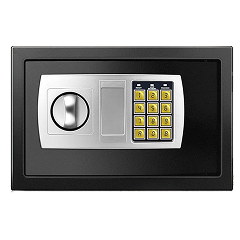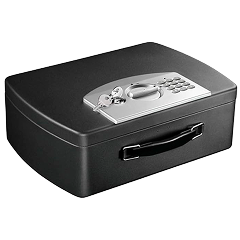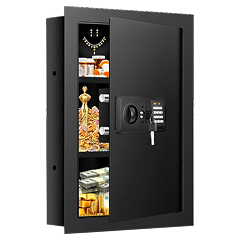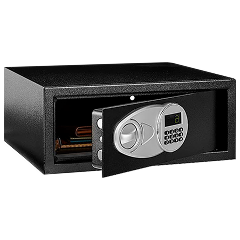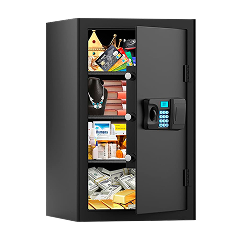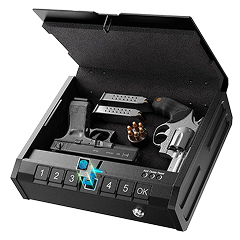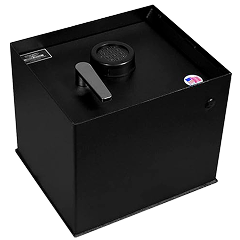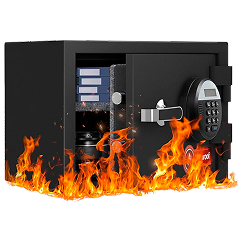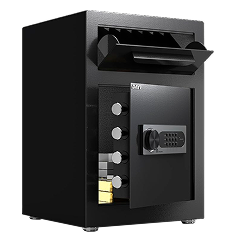Hace unos años, tomé una decisión aparentemente sencilla: comprar una caja fuerte para mi casa. Hoy en día, tengo dos unidades completamente diferentes: una caja fuerte de 36 kg con cerradura de combinación y un modelo compacto ignífugo con cerradura de llave.
Mi experiencia en ingeniería se manifestó durante esa primera compra, lo que me llevó a un laberinto de especificaciones, clasificaciones de resistencia al fuego y mediciones de espesor de acero que la mayoría de las reseñas apenas abordan superficialmente. Afronté la selección segura como cualquier problema de ingeniería: definir requisitos, analizar los modos de fallo y probar el rendimiento en condiciones reales.
Lo que descubrí con el uso diario cambió todo lo que creía saber sobre seguridad en el hogar. La caja fuerte con combinación guarda documentos importantes y pequeños objetos de valor, mientras que la caja fuerte ignífuga protege objetos que no se pueden reemplazar en caso de incendio.
La mayoría de las guías de compra se centran en especificaciones teóricas, pero aprendí por las malas que las estimaciones de capacidad de almacenamiento son excesivamente optimistas, que la comodidad lucha a diario contra la seguridad y que el peso de una caja fuerte de 36 kilos se convierte en una bendición o una maldición según tu perspectiva.
Esta guía elimina la publicidad superficial para ofrecerte información práctica que yo desearía haber tenido antes de gastar ese dinero. Te explicaré por qué elegí cerraduras mecánicas en lugar de electrónicas, cómo las clasificaciones de resistencia al fuego se traducen en protección real y los errores de almacenamiento que desearía haber evitado. En lugar de darte simplemente las especificaciones del fabricante, comparto las lecciones que solo se pueden aprender al tener una caja fuerte e investigar sobre ellas.
Comprensión de las clasificaciones de resistencia al fuego: la base de una selección segura
La protección contra incendios se convirtió en la principal preocupación tras investigar las estadísticas de incendios domésticos y percatarnos de la rapidez con la que suben las temperaturas. Aquí te explicamos cómo funcionan realmente las clasificaciones de resistencia al fuego y qué significan para tus necesidades específicas.
¿Por qué compré una caja fuerte ignífuga?
Tras calcular el coste de sustitución de los documentos familiares, las fotos y las unidades de copia de seguridad, me di cuenta de que la caja fuerte con combinación no ofrecía ninguna protección contra incendios. Las cajas fuertes estándar se centran en la prevención de robos, pero el fuego se propaga más rápido que los ladrones.
Ser ingeniero me enseñó a planificar considerando los modos de fallo más probables, y los incendios residenciales son mucho más frecuentes que los robos, al menos donde yo vivo. La decisión de comprar una unidad independiente con clasificación contra incendios se basó en un sencillo análisis de riesgos: podía reemplazar las joyas robadas, pero no podía recrear décadas de fotos familiares guardadas en discos duros viejos.
Desglose de las clasificaciones de tiempo: 30, 60, 90 y +120 minutos
Las clasificaciones de tiempo de seguridad contra incendios están respaldadas por resultados de pruebas de laboratorio, que muestran cuánto tiempo permanece el interior a una temperatura inferior a 175 °C cuando se lo expone a llamas estándar.
Solía pensar que 120 minutos debían ser el doble de buenos que 60, pero los incendios domésticos no funcionan así. La mayoría de los incendios residenciales consumen una habitación en unos 30-45 minutos y luego se propagan a otras partes o son extinguidos por los bomberos.
Mi caja fuerte de 60 minutos me da mucha protección sin tener que pagar el doble por un tiempo que probablemente nunca necesitaré. Gastar más por una protección de 120 minutos tiene sentido si vives en un lugar remoto del campo, donde los bomberos tardan una eternidad en llegar, pero, para la mayoría de nosotros, es solo dinero tirado.
Estándares de temperatura y lo que protegen
La resistencia al fuego no solo depende del tiempo; la temperatura también importa. Los materiales fallan a diferentes niveles de temperatura, y esto influye directamente en qué se debe almacenar y dónde:
- Clasificación de 650 °C: los documentos básicos en papel sobreviven
- Clasificación de 760 °C: las fotografías y algunos medios permanecen intactos
- Clasificación de 850 °C: los discos de ordenador, las unidades USB y los CD siguen funcionando
- Clasificación de 925 °C: máxima protección para todo tipo de medios
Mi caja fuerte ignífuga tiene una clasificación de 850 °C porque la mayoría de nuestros artículos irremplazables son dispositivos de almacenamiento digital. Superar la temperatura de 850 °C cuesta considerablemente más por una protección que no necesitaba.
Espesor y construcción del acero: ingeniería de la seguridad
Cuando empecé a comparar cajas fuertes, me di cuenta rápidamente de que el grosor del acero sigue la misma curva de seguridad exponencial que la resistencia al fuego. Mi caja fuerte con combinación tiene una puerta de 6 mm, que parece delgada hasta que intentas cortarla tú mismo. Pasar de 3 mm a 6 mm prácticamente duplica el tiempo de robo, pero subir a 9 mm o 12 mm crea aumentos exponenciales de la resistencia.
La diferencia entre el acero de 1/4″ y 3/8″ no radica solo en el grosor, sino también en la diferencia entre un equipo de aficionado y uno profesional. Para amenazas residenciales, de 1/4″ a 3/8″ ofrece el equilibrio ideal entre el precio y las necesidades de seguridad reales.
El grosor de la puerta llama la atención en los materiales de marketing, pero la construcción de las paredes revela la verdadera seguridad. Muchas cajas fuertes económicas cuentan con puertas gruesas sujetas a cuerpos de chapa fina que se abren como una lata de conserva. Mi caja fuerte de combinación utiliza acero uniforme en toda su superficie, mientras que la caja fuerte ignífuga prioriza la resistencia al calor sobre la resistencia al robo, con paredes más delgadas pero un aislamiento superior. La lección es esta: una caja fuerte es tan resistente como su componente más débil, y a los fabricantes les encanta anunciar su medida más resistente mientras ocultan sus vulnerabilidades.
Esto es lo que realmente me sorprendió del peso: mi caja fuerte de 36 kilos no parece tan pesada al abrirla, pero, si intentas moverla, entenderás por qué el peso es importante para la seguridad. Claro, una persona motivada probablemente podría cargar con ella, pero tendría que planificarlo: llevar herramientas, despejar el camino y pasar varios minutos forcejeando con una caja metálica incómoda, sin ningún lugar por donde sujetarla bien.
La mayoría de los ladrones quieren agarrar cosas y salir corriendo, no forcejear con objetos pesados que los frenen. La caja fuerte ignífuga de 9 kilos es una historia completamente distinta: cualquiera podría llevársela bajo el brazo y salir corriendo. Por eso tiene esos bordes reforzados en la puerta que dificultan mucho los ataques con palanca, aunque, obviamente, nada impide que alguien se la lleve entera.
Mecanismos de bloqueo: de lo tradicional a lo tecnológico
La cerradura determina cómo interactuarás con tu caja fuerte a diario, lo que la convierte en el aspecto más personal de tu decisión de compra. Esto es lo que aprendí del uso diario y de una investigación exhaustiva sobre diferentes sistemas.
Cerraduras de combinación vs. cerraduras de llave
Vivir con ambos tipos de cerradura me reveló desventajas que nunca consideré al comprar. La cerradura de combinación tarda entre 15 y 20 segundos en abrirse correctamente, pasando los números dos veces antes de llegar al último. Este proceso requiere concentración. He cometido errores de secuencia varias veces por distracción o prisa.
La caja fuerte ignífuga con llave se abre al instante, pero presenta un problema diferente: la gestión de llaves. Guardo la llave en un lugar secreto. Sin embargo, eso crea un único punto de fallo. Puedo perderla o alguien puede encontrarla. La cerradura de combinación es más segura, ya que la “llave” solo existe en la memoria, pero la cerradura con llave es más práctica en caso de emergencia.
Opciones electrónicas que investigué, pero evité
Los teclados digitales, los escáneres biométricos y los sistemas de doble cerradura dominaron la investigación inicial, pero las preocupaciones sobre la fiabilidad en el mundo real me llevaron a optar por opciones mecánicas. Los lectores biométricos parecen atractivos hasta que se consideran las tasas de fallos por dedos sucios, cortes o simples cambios en las huellas dactilares por el paso del tiempo.
Los teclados digitales solucionan el problema de la velocidad, pero introducen la dependencia de la batería y posibles fallos electrónicos. Las configuraciones de doble cerradura que combinan sistemas electrónicos y mecánicos parecían la mejor opción hasta que vi los sobreprecios y la mayor complejidad. Cada función electrónica añade posibles fallos que no existen en los sistemas puramente mecánicos.
¿Por qué elegí la fiabilidad mecánica?
Mi formación en ingeniería me enseñó que los sistemas más sencillos fallan con menos frecuencia, lo que me llevó a analizar cada tipo de cerradura teniendo en cuenta múltiples factores que importan en el uso en el mundo real:
Esta comparación dejó claro que las cerraduras mecánicas han funcionado de forma fiable durante más de un siglo. Dependen únicamente de una fabricación precisa y un mantenimiento adecuado. Los sistemas electrónicos requieren baterías, circuitos y software que pueden fallar de una forma que no puedes solucionar por tu cuenta. Si necesitas acceder a documentos importantes durante un apagón o una emergencia, probablemente quieras tener la certeza de que la caja fuerte se abrirá.
Sistemas de cerrojos, mecanismos adicionales de protección (relockers) y funciones de seguridad avanzadas
La mayoría de los propietarios se centran en la cantidad de cerrojos que tiene su caja fuerte. Sin embargo, lo que más importa es cómo esos cerrojos distribuyen la fuerza cuando alguien intenta forzarla. Mi caja fuerte con combinación usa tres cerrojos, y cada uno sujeta una parte diferente del marco de la puerta. Si alguien ataca con una palanca, no puede concentrar toda la fuerza en un solo punto.
Las cajas fuertes de un solo cerrojo son prácticamente una invitación a ser forzadas. Toda la fuerza de la palanca impacta en un punto y, eventualmente, algo tiene que ceder. Aumentar a tres cerrojos marca una gran diferencia, pero pasar de tres a seis o nueve cerrojos es prácticamente innecesario, a menos que guardes algo que valga más que un coche nuevo.
Los relockers resultaron ser mi medida de seguridad favorita, aunque nunca había oído hablar de ellos antes de comprar cajas fuertes. Así es como funcionan. Supongamos que alguien intenta perforar la cerradura principal. Si la caja fuerte tiene un relocker, al perforar la cerradura principal se activarán varios cerrojos adicionales que se cerrarán automáticamente.
Ahora la caja fuerte está cerrada aún más herméticamente que antes, y la única forma de abrirla es llamar a un cerrajero que cuente con herramientas especializadas. Mi caja fuerte tiene pasadores con resorte que se rompen si se manipula el mecanismo de la cerradura; al romperse, la gravedad coloca pernos adicionales en su lugar. Es como una trampa que dificulta abrir la caja fuerte cada vez que alguien la ataca.
Los intentos de intrusión en el mundo real siguen patrones predecibles que estas capas de seguridad protegen.
- Los ataques con palanca tienen como objetivo las juntas de las puertas y se basan en la multiplicación del apalancamiento, que los sistemas de múltiples pernos interrumpen al distribuir la resistencia.
- Los ataques de perforación apuntan al mecanismo de bloqueo, lo que activa mecanismos de cierre que hacen que la caja fuerte sea más difícil de abrir que antes de que comenzara el ataque.
- Los métodos de corte se centran en secciones de paredes delgadas, lo cual no se logra con el espesor adecuado del acero y la construcción reforzada.
La seguridad en capas funciona porque cada método requiere herramientas y habilidades diferentes, lo que obliga a los ladrones a estar preparados para todo o darse por vencidos cuando su enfoque principal falla.
Tipos y aplicaciones seguras: adecuación entre el propósito y el diseño
Los diferentes tipos de cajas fuertes se especializan según tus necesidades. No compres una caja fuerte sin conocer su uso y características principales. A continuación, te mostramos cómo funciona cada tipo de caja fuerte en situaciones reales.
Cajas fuertes para armas vs. cajas fuertes para el hogar: características especiales, ventajas e inconvenientes
Las cajas fuertes para armas priorizan el acceso rápido y el almacenamiento a largo plazo sobre la máxima seguridad. Suelen utilizar acero más delgado y cerraduras más sencillas para ajustarse a los precios que muchos propietarios de armas esperan. La distribución interior se centra en la organización de las armas con acolchado de espuma, soportes para rifles y porta pistolas que ocupan el espacio de otros objetos de valor.
Las cajas fuertes domésticas generales cambian estas prioridades, ofreciendo mayor protección antirrobo gracias a un acero más grueso y mecanismos de cierre más sólidos, a la vez que ofrecen un almacenamiento flexible para documentos, joyas y dispositivos electrónicos. Mi caja fuerte con combinación entra en la categoría de caja fuerte doméstica porque necesitaba protección antirrobo más que un almacenamiento especializado para armas, aunque también podía guardar armas de fuego pequeñas.
¿Por qué compré unidades separadas? Cajas fuertes ignífugas vs. cajas de seguridad
La resistencia al calor y la protección antirrobo requieren enfoques de ingeniería fundamentalmente diferentes que rara vez coexisten eficazmente en una misma unidad. Las cajas fuertes ignífugas utilizan un aislamiento grueso que reduce el espacio interior y aumenta el peso sin mejorar la seguridad, mientras que las cajas fuertes de seguridad priorizan el grosor del acero para la resistencia al robo en lugar de la protección contra el calor.
Mi decisión de comprar unidades separadas se debió a una cuestión de física: los materiales que protegen contra temperaturas de 850 °C durante 60 minutos no ofrecen la misma resistencia antirrobo que el acero endurecido, diseñado para detener herramientas de corte. Existen unidades combinadas, pero sacrifican ambas funciones para alcanzar el precio de venta al público, lo que resulta en una resistencia al calor mediocre y una seguridad adecuada en lugar de la excelencia en ambos aspectos.
Opciones de instalación: consideraciones sobre suelo, pared y portátiles
El método de instalación que elijas determinará tanto el nivel de seguridad como la comodidad. A continuación, se muestra una comparación de las diferentes opciones de montaje para uso residencial:
Mi unidad portátil representa un compromiso de seguridad que hice por flexibilidad: puedo moverla si realmente lo necesito, pero cualquier otra persona también puede. Las cajas fuertes de suelo eliminan la desventaja de la portabilidad, pero requieren una instalación permanente que no estaba listo para emprender en mi casa actual. Las cajas fuertes de pared ofrecen ventajas de ocultación, pero limitan la capacidad y requieren modificaciones estructurales que muchos propietarios evitan.
Cajas fuertes de depósito: cuando la función de ranura de depósito tiene sentido
Las cajas fuertes con ranuras de depósito se utilizan para aplicaciones específicas donde se necesita asegurar objetos sin abrir el compartimento principal repetidamente. Los comercios minoristas las utilizan para depositar efectivo, pero los propietarios de viviendas rara vez necesitan esta función, a menos que tengan un negocio en casa o manipulen con frecuencia objetos valiosos que otros necesiten proteger.
El mecanismo de ranura de depósito añade complejidad y posibles puntos de fallo, a la vez que reduce el espacio interior, lo que lo hace innecesario para aplicaciones residenciales típicas. Consideré brevemente un modelo de depósito, pero me di cuenta de que no podía justificar el coste y la complejidad adicionales para los patrones de uso reales.
Planificación de la capacidad y organización interior
La planificación de la capacidad resultó ser el mayor error de cálculo durante mi búsqueda de una caja fuerte, y aprendí lecciones muy valiosas sobre la realidad del almacenamiento frente a las especificaciones del fabricante. Inicialmente, calculé que necesitaba unos 0,022 metros cúbicos basándome en los documentos y objetos de valor que planeaba guardar, así que compré una caja fuerte de 0,030 metros cúbicos, pensando que tenía espacio de sobra para crecer.
La realidad me golpeó de lleno cuando intenté meterlo todo dentro: las formas irregulares de los joyeros, el grosor de las carpetas y las dimensiones incómodas de las unidades de copia de seguridad consumían el espacio mucho más rápido de lo previsto. En seis meses, jugaba al Tetris cada vez que abría la caja fuerte y empecé a dejar fuera objetos menos importantes, simplemente porque no cabían bien.
La elección del sistema de estanterías afecta la usabilidad diaria más de lo que sugiere cualquier hoja de especificaciones. Algunas cajas fuertes con combinación vienen con compartimentos fijos que pueden parecer lógicos al comprarlas, pero pueden convertirse en limitaciones frustrantes a medida que cambian las necesidades de almacenamiento.
Las ranuras predeterminadas funcionan perfectamente para artículos específicos, pero desperdician espacio cuando se necesita guardar algo ligeramente diferente en tamaño o forma. La caja fuerte ignífuga utiliza estantes ajustables que puedo reconfigurar según lo que guarde, y esta flexibilidad ha resultado muy valiosa a medida que nuestras necesidades de recopilación de documentos y almacenamiento de copias de seguridad han cambiado con el tiempo.
Los requisitos de almacenamiento de documentos varían considerablemente según el tamaño del papel; este detalle puede determinar el éxito o el fracaso de tu planificación de capacidad:
- Documentos de tamaño carta estándar: caben fácilmente en la mayoría de las cajas fuertes y se apilan de manera eficiente para una máxima densidad de almacenamiento
- Documentos de tamaño legal: requieren una profundidad de 35 cm en lugar de 28 cm, lo que elimina considerar muchas opciones de cajas fuertes compactas
- Documentos de gran tamaño: escrituras de propiedad, certificados y planos arquitectónicos necesitan soluciones de almacenamiento personalizadas que la mayoría de las cajas fuertes no pueden acomodar.
- Carpetas y archivadores: añaden un grosor sustancial que convierte una pila de documentos de 3 cm en un requisito de almacenamiento de 8 cm
- Dispositivos de almacenamiento digital: los discos duros, las memorias USB y los medios de copia de seguridad necesitan carcasas protectoras que multiplican su espacio de almacenamiento.
Planificar el crecimiento implica comprar entre un 25 % y un 50 % más de capacidad de la que sugieren tus necesidades actuales, ya que las necesidades de almacenamiento seguro aumentan con el tiempo. Ojalá hubiera comprado cajas fuertes de tamaño superior, aceptando el mayor coste por la comodidad a largo plazo en lugar de lidiar con la constante gestión del espacio que afronto a día de hoy.
Fabricantes líderes de cajas fuertes
La reputación de la marca a menudo no se corresponde con la calidad real del producto, y las condiciones de garantía revelan más sobre la confianza en el fabricante que los materiales de marketing. Esto es lo que mi investigación y experiencia como propietario me han enseñado sobre cada uno de los principales fabricantes.
SentrySafe: enfoque en la protección contra incendios con ventajas e inconvenientes en seguridad
SentrySafe domina el mercado minorista gracias a sus alianzas con grandes superficies, pero sus prioridades de ingeniería anteponen la resistencia al calor sobre la resistencia al robo. Sus cajas fuertes ignífugas destacan por su excelente aislamiento y un control fiable de temperatura, aunque las características de seguridad parecen secundarias a la resistencia al fuego. Su servicio de atención al cliente fue muy receptivo a las preguntas básicas, y su disponibilidad de repuestos supera a la de fabricantes más pequeños. La desventaja reside en su construcción de acero más delgada y sus mecanismos de cierre más sencillos, lo que refleja su posicionamiento en el mercado masivo en lugar de una filosofía de diseño que prioriza la seguridad.
Liberty: especialistas en cajas fuertes para armas con una construcción sólida
Liberty se forjó una reputación vendiendo a propietarios de armas que buscan una construcción robusta sin gastar una fortuna. Sus cajas fuertes utilizan acero más grueso que la mayoría de sus competidores en el mismo rango de precio, y los sistemas de cerrojo funcionan correctamente. ¿La desventaja? Su resistencia al fuego está por debajo de la de las empresas especializadas en protección contra el calor.
He notado que se centran mucho en vender a través de distribuidores locales en lugar de grandes superficies, lo que significa que recibirás un mejor servicio, pero probablemente pagarás más debido a los sobreprecios. La mayoría de sus cajas fuertes incluyen garantías de 3 a 5 años, lo que me indica que confían en que no se romperán justo después de comprarlas.
Cannon: opciones económicas con claras limitaciones
Cannon se dirige a quienes buscan una caja fuerte sin gastar una fortuna. Encontrarás sus cajas fuertes en grandes superficies con precios que hacen que otras marcas parezcan caras. ¿La clave? Reducen costes usando acero más delgado y cerraduras más sencillas que cumplen con la función de seguridad básica, pero no detendrán a nadie con las herramientas y el tiempo necesarios.
Sus garantías suelen tener una duración de 1 a 2 años, lo cual se ajusta a lo que pagas. Si vas a alquilarla y necesitas algo temporal, o simplemente quieres mantener a los niños alejados de documentos importantes, las cajas fuertes Cannon son ideales.
Stack-On: segmento económico con seguridad mínima
Stack-On se dirige al mercado económico con cajas fuertes básicas que funcionan más como contenedores de almacenamiento seguros que como verdaderos dispositivos de seguridad. Su construcción utiliza acero delgado y cerraduras sencillas que impiden el acceso casual, pero no detienen a ladrones decididos con herramientas básicas.
Su resistencia al calor es mínima o inexistente en la mayoría de los modelos, lo que los hace adecuados principalmente para organizar documentos importantes, en lugar de proteger objetos de valor. Su precio refleja estas limitaciones, ya que a menudo cuestan entre un 30 % y un 50 % menos que modelos comparables de otros fabricantes, a la vez que ofrecen una seguridad proporcionalmente menor.
Instalación y montaje: seguridad más allá de la propia caja fuerte
Los sistemas de pernos de anclaje representan la diferencia entre la seguridad real y la falsa confianza; sin embargo, preferí la portabilidad a la protección en mis dos cajas fuertes. La caja fuerte con combinación de 36 kg parece segura hasta que te das cuenta de que dos personas pueden sacarla en menos de un minuto. En cambio, la caja fuerte portátil contra incendios ofrece cero resistencia al robo sin necesidad de bloquearla. Los ladrones profesionales saben que robar la caja fuerte completa les da tiempo ilimitado para forzarla a su antojo, lo que convierte a las unidades portátiles en un riesgo fundamental para la seguridad.
El montaje en el suelo ofrece la mayor seguridad, pero requiere perforar hormigón y una instalación permanente, algo que no estaba dispuesto a asumir como propietario. El montaje en la pared funciona para cajas fuertes pequeñas y ofrece ocultación, aunque limita la capacidad y requiere montantes de pared adecuados. Como ingeniero, podría encargarme yo mismo del montaje en el suelo con un taladro percutor y anclajes para hormigón, pero la permanencia me ha impedido realizar lo que debería haber sido una mejora de seguridad obvia.
Algunos códigos de construcción pueden ser una consideración inesperada para la instalación permanente, al igual que las posibles restricciones de la asociación de propietarios. Las implicaciones del seguro también me sorprendieron: algunas pólizas ofrecen descuentos por cajas fuertes instaladas correctamente, mientras que otras exigen la notificación de las instalaciones de seguridad. Consulta los códigos locales y los requisitos del seguro antes de comprar, no después, para evitar descubrir limitaciones que podrían haber influido en tu elección de caja fuerte.
Errores de compra comunes que veo
Tras experimentar con cajas fuertes e investigar a fondo, he identificado los errores que más dinero y frustración generan en los compradores. Estos errores parecen obvios en retrospectiva, pero nos pillaron desprevenidos a mí y a muchísimos otros compradores durante el proceso de compra.
- Subestimar las necesidades de capacidad: compré 0,030 metros cúbicos para 0,022 metros cúbicos de cosas, pero las formas irregulares y las carpetas gruesas consumían espacio mucho más rápido de lo calculado.
- Elegir la comodidad por encima de la seguridad: la cerradura con llave parecía más rápida que la de combinación, pero crea un único punto de fallo y me obliga a administrar la seguridad de la llave física
- Ignorar las especificaciones de temperatura de clasificación de fuego: casi compré protección de 650 °C antes de darme cuenta de que las unidades de respaldo necesitaban 850 °C para sobrevivir
- Errores en la planificación de la ubicación: elegí lugares en función del espacio disponible en lugar de la seguridad y la facilidad de uso diaria, lo que resultó en un acceso incómodo.
- Centrarse solo en el grosor de la puerta: el marketing pone énfasis en el acero de la puerta mientras oculta la construcción delgada de la carcasa, que se puede abrir fácilmente.
- Comprar para las necesidades actuales en lugar del crecimiento futuro: los requisitos de almacenamiento seguro solo se expanden con el tiempo, y comprar muy poco significa un reemplazo costoso.
Compras inteligentes: especificaciones que realmente importan
Para superar la publicidad superficial es necesario comprender qué especificaciones se traducen en protección real y cuáles son solo cifras impresionantes. Aquí te explicamos cómo centrar la investigación en lo que realmente importa.
Comprensión de las clasificaciones UL para la protección en el mundo real
Las clasificaciones UL (Underwriters Laboratories) ofrecen resultados de pruebas estandarizadas que contradicen las afirmaciones de marketing de los fabricantes. UL-TL15 significa que personal capacitado no pudo forzar la seguridad en 15 minutos con herramientas comunes, mientras que UL-TL30 amplía ese tiempo a 30 minutos con equipos avanzados. La mayoría de las cajas fuertes residenciales carecen de clasificación UL debido al coste de las pruebas, pero comprender el sistema me ayudó a evaluar las afirmaciones de los fabricantes con mayor rigor durante la investigación.
La duración de la garantía como indicador de confianza en la fabricación
Esto es algo que descubrí mientras compraba: la duración de la garantía dice más sobre la calidad de una caja fuerte que cualquier folleto de marketing.
- Las empresas que ofrecen garantías de un año básicamente están diciendo: “Esperamos que dure lo suficiente para que olvides dónde la compraste”.
- De tres a cinco años significa que tienen bastante confianza en su ingeniería y materiales.
- Las garantías de por vida son la norma de oro. Esto significa que la empresa apuesta toda su reputación a que la caja fuerte no fallará bajo tu cuidado.
Mi caja fuerte con combinación venía con una garantía de cinco años, lo que me ayudó a convencerme de que el fabricante no estaba simplemente juntando componentes baratos y esperando lo mejor.
Rangos de precios y lo que realmente obtienes
Los precios seguros siguen niveles predecibles en los que gastar entre un 20 % y un 30 % más generalmente brinda entre un 50 % y un 70 % más de seguridad.
- Por menos de 175 € obtienes almacenamiento básico de documentos.
- Entre 175 € y 435 € ofrecen una protección antirrobo decente con resistencia básica al calor.
- Entre 435 € y 870 € ofrece seguridad seria con buena clasificación de resistencia al fuego.
Para la mayoría de los propietarios, el rango de 260 € y 520 € ofrece el mejor valor para una protección real sin características premium.
Distribuidores online vs. locales: mi experiencia de compra
Las tiendas en línea ofrecen mejores precios, pero eliminan la posibilidad de evaluar la calidad de la construcción en persona. Compré la caja fuerte con combinación online y ahorré 130 €, pero no pude verificar el grosor del hasta la entrega.
Los distribuidores locales cobran más, pero ofrecen entrega, instalación y asesoramiento técnico. El distribuidor de cajas fuertes ignífugas me ayudó a comprender las diferencias en la clasificación de resistencia al fuego que las descripciones en línea pasaban por alto.
¿Qué caja fuerte es adecuada para ti?
Tu caso de uso principal debe impulsar todas las demás decisiones en una selección segura, porque las diferentes necesidades de almacenamiento requieren prioridades de ingeniería fundamentalmente diferentes.
- El almacenamiento de documentos exige resistencia al calor por encima de seguridad, lo que hace que las cajas fuertes resistentes al fuego con cerraduras básicas sean la opción lógica.
- El almacenamiento de artículos valiosos requiere protección antirrobo mediante acero grueso y mecanismos de bloqueo de alta resistencia.
- El almacenamiento de armas de fuego requiere un acceso rápido y los diseños interiores especializados que brindan las cajas fuertes para armas, aunque las cajas fuertes domésticas generales funcionan si no necesitas un despliegue rápido.
- El almacenamiento combinado genera las decisiones más complejas. Lo resolví con dos cajas fuertes separadas en lugar de sacrificar ambas funciones en una sola unidad, pero las limitaciones de presupuesto podrían obligarte a priorizar tu necesidad de protección más importante.
Recomiendo invertir en características que aborden tus amenazas reales, en lugar de en especificaciones impresionantes que no necesitas. Invierte entre 85 € y 175 € adicionales en acero con un grosor adecuado y una clasificación de resistencia al fuego que se ajuste a tu almacenamiento. Evita cerraduras electrónicas costosas y características premium a menos que resuelvan problemas específicos.
Las limitaciones de espacio deberían descartar opciones al principio de la búsqueda, en lugar de obligarte a hacer concesiones incómodas más adelante. Primero debes medir el área de instalación y luego comparar precios dentro de esos límites.
Para quienes compran por primera vez, recomiendo empezar con una caja fuerte de calidad de 0,045 a 0,060 metros cúbicos, de entre 350 € y 480 €, elegir cerraduras mecánicas en lugar de electrónicas y comprar una con una capacidad ligeramente mayor de la que creas necesitar. Instálala correctamente desde el primer día, incluso si eso implica contratar a un profesional, ya que las cajas fuertes sin montar ofrecen una falsa seguridad.


